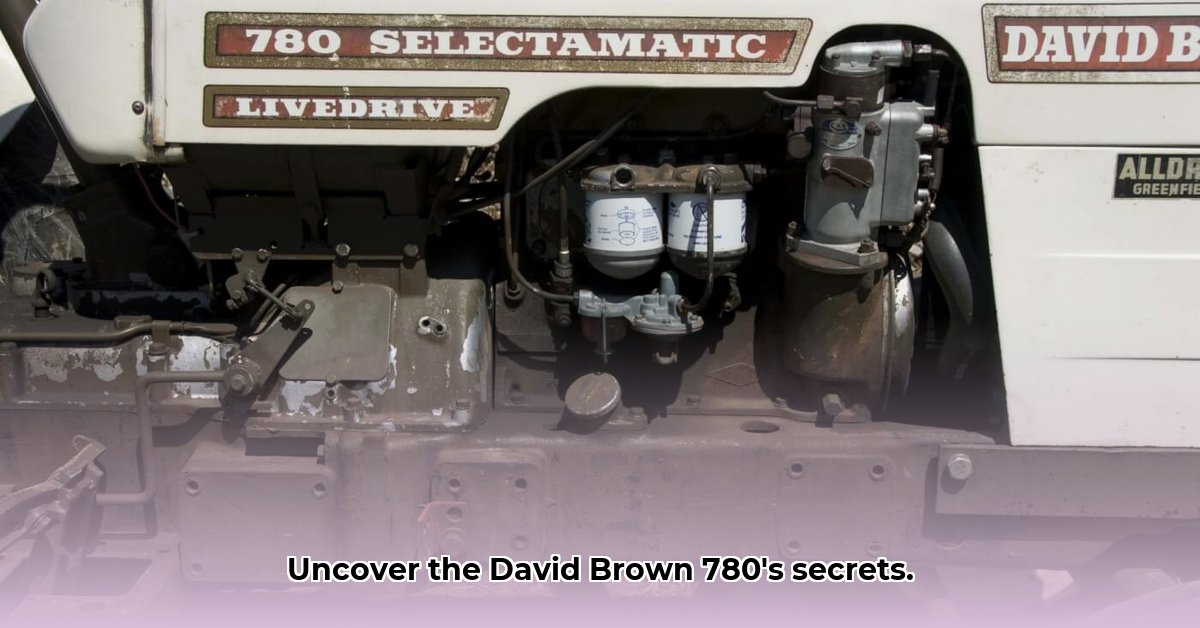
The David Brown 780 tractor—a name synonymous with robust agricultural machinery and enduring legacy. This guide delves into the history, specifications, and enduring appeal of this iconic machine, offering insights for farmers, collectors, and enthusiasts alike. Whether you're considering purchasing a David Brown 780, restoring one, or simply admiring its timeless design, this comprehensive guide provides valuable information. For additional resources, check out this helpful website.
A Look Back at a Farming Icon
The mid-20th century saw a significant evolution in agricultural technology. The David Brown 780 emerged as a powerful and reliable workhorse significantly impacting farming practices. Its sturdy construction and impressive power-to-weight ratio set it apart from its contemporaries. This made it surprisingly nimble for its size, allowing it to maneuver efficiently in various field conditions. The 780's reliability, a crucial factor for farmers, further cemented its reputation. Minimizing downtime was paramount, and the David Brown 780 excelled in this aspect. Why was reliability such a crucial factor for farmers in this era? Because downtime directly translated to lost productivity and revenue.
Under the Hood: Engineering Delights
While precise engine specifications vary slightly across different 780 models, several key features consistently emerge. Most models likely featured a diesel engine—a powerhouse for its time—delivering sufficient torque for heavy implements. The emphasis on robust construction using durable materials is considered a major contributor to the tractor's longevity. What materials were primarily used in the construction of the David Brown 780? Further research is needed to pinpoint the exact materials used, but the focus on durability is well documented. The transmission system, though relatively simple by today's standards, was designed for smooth gear changes, minimizing operator strain and machinery wear. However, detailed technical blueprints for various sub-models remain scarce, leaving some aspects open for further investigation by enthusiasts.
More Than Just Plowing: Versatility in Action
The David Brown 780's versatility extended far beyond plowing. Its three-point hitch system enabled a wide array of attachments, streamlining farm operations. This adaptability was a significant economic advantage, saving time and labor. The tractor's power take-off (PTO) shaft further increased its capabilities by powering various implements. How did the versatility of the David Brown 780 impact farming efficiency? The ability to quickly switch between tasks significantly increased overall productivity.
The Human Element: A Farmer's Perspective
Beyond technical specifications, the David Brown 780's impact is reflected in anecdotal accounts from farmers who used it. The machine is repeatedly described as "reliable," "tough," and "easy to maintain." This straightforward design allowed for easier routine maintenance, even for those with limited mechanical knowledge – reducing reliance on specialized mechanics. What were some of the most common comments from farmers regarding the 780's ease of use and maintenance? Anecdotal evidence suggests that its simplicity was appreciated.
The 780's Enduring Appeal: A Modern Legacy
Today, the David Brown 780 is highly sought after by collectors, extending its legacy beyond its practical farming applications. Its enduring appeal stems from the quality of its engineering and the nostalgia it evokes. Well-maintained examples remain functional, highlighting the machine's lasting value. Restoration projects are common, breathing new life into these agricultural icons. This continuing interest underscores the appreciation for a bygone era of robust, dependable machinery. What are some of the key factors contributing to the collector's interest in the David Brown 780? The combination of historical significance, robust engineering, and the potential for restoration drives collector interest.
David Brown 780 Tractor: Specifications (Approximate Values)
| Specification | Value (Approximate) | Notes |
|---|---|---|
| Engine Type | Diesel | Several engine variations likely existed |
| Horsepower | 70-80 HP (depending on model) | Exact horsepower may vary across models |
| Weight | Approximately 7,000-8,000 lbs | Weight can vary based on configuration |
| Transmission | Manual, typically 8 forward gears | Specific gear ratios likely differed by model |
| PTO Power | (Variable, dependent on engine) | Needs further research to pinpoint values |
Maintenance Tips (General Guidelines)
While detailed maintenance instructions are found in original service manuals, here are some general guidelines:
- Regular Oil Changes: Follow the manufacturer's recommended intervals for optimal engine performance.
- Fluid Checks: Regularly check and top off coolant, transmission oil, and hydraulic fluid levels.
- Filter Replacements: Replace air, fuel, and oil filters according to the maintenance schedule.
- Visual Inspection: Regularly inspect for damage, leaks, or wear and tear.
- Lubrication: Keep moving parts lubricated to prevent excessive wear and tear.
Note: Always consult a service manual and/or qualified mechanic for specific maintenance procedures. This guide offers general information only.
Key Takeaways
- The David Brown 780 was a significant advancement in agricultural technology, known for its reliability and versatility.
- Its robust construction and straightforward design contributed to its longevity and enduring appeal.
- The 780's versatility, facilitated by its three-point hitch and PTO, made it a valuable asset for diverse farming operations.
This guide provides a general overview of the David Brown 780 tractor. Specific details may vary based on individual models. Further research is encouraged for more in-depth information.